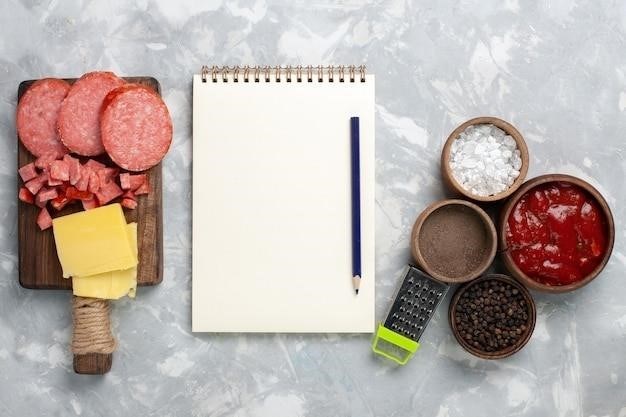Signature Select Ham Cooking Instructions⁚ A Comprehensive Guide
This guide provides comprehensive instructions for cooking Signature Select ham․ Methods include oven reheating at 275°F (12-15 minutes per pound)‚ ensuring moisture retention with foil and water․ Alternative methods like stovetop and microwave are also discussed‚ along with safety precautions and serving suggestions․
Pre-Cooked Ham Reheating
Reheating a pre-cooked Signature Select ham is crucial for achieving optimal flavor and texture․ The goal is to gently warm the ham without drying it out‚ preserving its natural juices and enhancing its delicious taste․ Several methods exist‚ each offering unique advantages․ Oven reheating is a popular choice‚ allowing for even heating throughout the ham․ This involves placing the ham in a roasting pan‚ often adding a small amount of water to the bottom to create moisture․ Covering the pan with aluminum foil helps to retain moisture‚ preventing the ham from becoming dry or tough․ The temperature and time will vary depending on the size and weight of the ham‚ but generally‚ a lower temperature (around 275-325°F) for a longer duration ensures a more tender result․ Always use a meat thermometer to check the internal temperature‚ ensuring it reaches a safe temperature of 140°F before serving․ This guarantees that the ham is thoroughly heated‚ eliminating any potential food safety concerns․ Alternatively‚ stovetop or microwave methods can be employed for quicker reheating‚ but careful attention to temperature and time is necessary to avoid overcooking․
Oven Reheating Methods⁚ Temperature and Time
For optimal results when oven reheating your Signature Select ham‚ maintaining the correct temperature and cooking time is paramount․ Generally‚ a lower temperature is preferred to prevent the ham from drying out․ A temperature range of 275°F to 325°F is commonly recommended․ Using a lower temperature (around 275°F) will require a longer cooking time‚ ensuring even heating and preventing the exterior from becoming overcooked before the interior reaches a safe temperature․ Higher temperatures (around 325°F) can reduce cooking time‚ but increase the risk of dryness․ The cooking time is largely dependent on the weight of the ham․ A common guideline suggests 12-15 minutes of cooking time per pound of ham at 275°F․ However‚ this is just an estimate‚ and monitoring the internal temperature with a meat thermometer is crucial․ Aim for an internal temperature of 140°F for a fully cooked‚ reheated ham․ Remember to always check the packaging for specific instructions provided by the manufacturer‚ as cooking times may vary slightly depending on the type and preparation of your Signature Select ham․ Always err on the side of caution; slightly undercooked ham can be reheated‚ but overcooked ham cannot be salvaged․
Reheating a Pre-Cooked Ham⁚ Maintaining Moisture
Reheating a pre-cooked ham requires a delicate approach to prevent it from becoming dry and tough․ The key to success lies in retaining its natural moisture․ Several techniques can help achieve this․ One effective method involves placing the ham in a shallow roasting pan‚ adding a small amount of water (about ½ inch) to the bottom of the pan․ Covering the pan tightly with aluminum foil creates a sealed environment‚ trapping steam and preventing moisture loss․ This steaming effect helps keep the ham moist and juicy throughout the reheating process․ Alternatively‚ you can place the ham on a rack set inside a roasting pan‚ again adding a small amount of water to the bottom․ The rack elevates the ham‚ allowing for even heat circulation and preventing it from stewing in its own juices․ Regardless of the method chosen‚ closely monitor the ham’s internal temperature using a meat thermometer to ensure it reaches a safe temperature of at least 140°F without overcooking․ Basting the ham periodically with its own juices or a flavorful glaze can also contribute to moisture retention and enhance its flavor․ Remember‚ patience is key; slow and gentle reheating at a lower temperature is more effective in preserving the ham’s moisture than rapid‚ high-heat reheating․
Cooking Times Based on Ham Weight
Determining the appropriate cooking time for your Signature Select ham is crucial for achieving optimal results․ The weight of the ham significantly impacts the cooking time‚ as larger hams require longer cooking periods to ensure they are heated thoroughly and evenly․ A general guideline suggests approximately 12-15 minutes of cooking time per pound at 275°F (135°C) for a fully cooked ham that only needs reheating․ However‚ this is just an estimate‚ and it’s essential to use a meat thermometer to confirm the ham has reached a safe internal temperature of at least 140°F (60°C)․ For raw hams requiring full cooking‚ the cooking time will be considerably longer and will need to reach a higher internal temperature of 145°F (63°C)․ Always consult the specific cooking instructions provided on your ham’s packaging‚ as these instructions are tailored to the particular product and may vary slightly depending on factors such as the ham’s size‚ shape‚ and whether it’s bone-in or boneless․ Remember that even after the ham reaches the desired internal temperature‚ allowing it to rest for 20-30 minutes before carving allows the juices to redistribute‚ resulting in a more tender and flavorful final product․ Using a meat thermometer is the most reliable method for ensuring the ham is cooked to a safe temperature regardless of its weight․

Alternative Reheating Methods⁚ Stovetop and Microwave
While oven reheating is the most common method‚ alternative techniques exist for warming your Signature Select ham․ For stovetop reheating‚ gently simmer slices of ham in a small amount of liquid‚ such as water or broth‚ until heated through․ This method is ideal for smaller portions or when you need to reheat the ham quickly․ Keep in mind that this method may not be suitable for reheating the entire ham at once‚ as it can be challenging to ensure even heating․ Alternatively‚ microwave reheating offers a convenient‚ albeit potentially less even heating method․ To microwave your ham‚ place the slices on a microwave-safe plate and cover loosely with a damp paper towel․ Heat on medium power in short bursts‚ checking frequently to prevent overcooking and drying out the ham․ The cooking time will vary depending on the wattage of your microwave and the amount of ham being reheated․ Remember to always exercise caution when using the microwave‚ as uneven heating can occur․ For both stovetop and microwave methods‚ closely monitor the ham’s temperature to prevent overcooking․ Using a meat thermometer will ensure the ham reaches a safe internal temperature of at least 140°F (60°C) before serving‚ regardless of the chosen reheating method․ Always refer to your specific ham’s packaging for detailed instructions․
Safety Precautions⁚ Internal Temperature and Food Safety

Ensuring food safety is paramount when reheating any pre-cooked meat‚ including Signature Select ham․ The most crucial safety precaution is achieving a safe internal temperature throughout the ham․ Use a food thermometer to check the internal temperature in multiple areas‚ ensuring it reaches at least 140°F (60°C)․ This temperature kills harmful bacteria that may be present․ Do not rely solely on visual cues‚ as the ham may appear cooked even if it hasn’t reached a safe internal temperature․ If the ham’s packaging indicates a higher recommended temperature‚ follow those instructions carefully․ Before reheating‚ inspect the ham for any signs of spoilage‚ such as unusual discoloration‚ foul odor‚ or slimy texture․ Discard any ham showing these signs․ If you are unsure about the ham’s freshness‚ err on the side of caution and discard it․ After reheating‚ promptly refrigerate any leftover ham within two hours to prevent bacterial growth․ Store the ham in an airtight container to maintain its quality and prevent cross-contamination․ Proper food handling and storage practices are essential for preventing foodborne illnesses․ Always wash your hands thoroughly with soap and water before and after handling the ham․ Clean and sanitize all surfaces and utensils that come into contact with the ham․ Following these safety measures will help ensure that you enjoy your Signature Select ham safely and without risk of foodborne illness․
Serving Suggestions⁚ Hot or Cold Options
Signature Select ham offers delightful versatility‚ serving equally well hot or cold‚ making it perfect for various occasions․ For a classic holiday presentation‚ serve the reheated ham hot‚ sliced generously and arranged on a platter․ Accompany it with traditional sides like scalloped potatoes‚ green bean casserole‚ or cranberry sauce for a complete and satisfying meal․ The warm ham pairs excellently with mustard‚ providing a tangy contrast to the rich meat․ If you prefer a lighter approach‚ serve thin slices of cold ham on crusty bread or crackers with a side of fruit salad or a fresh green salad․ Consider adding a flavorful glaze for a touch of sweetness to your hot ham․ Honey-mustard or brown sugar glazes complement the ham’s savory taste exceptionally well․ For a more casual setting‚ cube the ham and add it to salads‚ omelets‚ or quiches for a protein-packed boost․ Cold ham also makes a delicious addition to sandwiches and wraps‚ providing a flavorful and convenient meal option․ The versatility of Signature Select ham extends to its leftovers; cubed ham can enhance pasta dishes‚ frittatas‚ or even be added to your favorite soup recipes․ Explore the various possibilities and discover your preferred way of savoring this versatile and delicious ham․
Troubleshooting⁚ Overcooked or Dry Ham
Overcooked or dry ham is a common concern‚ but easily avoidable with proper cooking techniques and careful attention to time and temperature․ If your ham is dry‚ it likely means it was cooked for too long at too high a temperature‚ or lacked sufficient moisture during the cooking process․ To prevent dryness‚ always follow the recommended cooking times based on the ham’s weight‚ using a meat thermometer to ensure it reaches the safe internal temperature of 140°F (60°C) for fully cooked ham‚ or 145°F (63°C) if cooking from raw․ Adding a small amount of water to the bottom of the roasting pan‚ covering the ham with foil‚ and using lower temperatures can help retain moisture․ If your ham is overcooked‚ it will likely be tough and possibly have a dry texture․ While you can’t reverse overcooking‚ you can try to improve the texture by adding moisture․ Consider slicing the ham thinly and serving it with a flavorful sauce‚ such as a honey-mustard glaze or a creamy horseradish sauce‚ to add richness and enhance the flavor․ You can also incorporate the ham into other dishes‚ such as casseroles or salads‚ to mask any dryness․ For future cooking‚ ensure you use a reliable meat thermometer and closely monitor the cooking time to prevent overcooking․ Adjust the cooking method according to the type of ham—spiral-sliced hams may require shorter cooking times than bone-in hams․ Remember‚ consistent monitoring is key to achieving a perfectly cooked‚ juicy‚ and flavorful Signature Select ham․